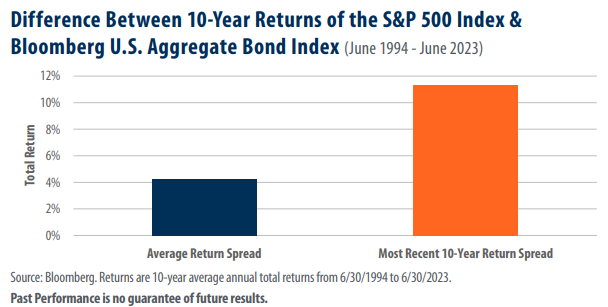
View from the Observation Deck
When it comes to allocating capital, one of the most difficult decisions investors face is whether they’re being appropriately
compensated for risk. Generally, but certainly not always, higher risk investments should reward investors with higher
returns. One of the more challenging times in recent history to determine this risk/reward ratio was during the wake of
the financial crisis in 2009, in our opinion. Since then, investors have had to navigate a myriad of headwinds to growth,
including the ending of the Federal Reserve’s Quantitative Easing program, a European Debt Crisis, the COVID-19 pandemic,
surging interest rates, and a banking crisis, to name a few. For today’s post, we set out to determine the question: in the
wake of the financial crisis, was a longer-term investment in the equity markets worth the risk? To do so we took the
average of the spread between the 10-year average annual total returns of the S&P 500 Index and the Bloomberg U.S.
Aggregate Bond Index over a 30-year period between 6/30/94 and 6/30/23 and compared it to the most recent spread
between the 10-year return of the two indices.
• As the chart reveals, the S&P 500 Index experienced total returns that were 11.3 percentage points higher than the
total returns in the Bloomberg U.S. Aggregate Bond Index for the most recent 10-year period ended 6/30/23.
• Also noted in the chart, for the 30-year period ended 6/30/23, the S&P 500 Index experienced rolling 10-year average
annual total returns that were 4.2 percentage points higher than those of the Bloomberg U.S. Aggregate Bond Index.
• The 10-year average annual total return for the S&P 500 and Bloomberg U.S. Aggregate Bond Indices stood at 12.83%
and 1.51%, respectively, for the period ended 6/30/23 (not in table).
• The S&P 500 Index experienced its highest 10-year average annual total return of 18.74% over the period ended
6/30/1999, while the Bloomberg U.S. Aggregate Bond Index saw its highest 10-year average annual total return of
11.59% during the period ended 6/30/94.
• The S&P 500 Index experienced its lowest 10-year average annual total return of -2.22 over the period ended
6/30/2009, while the Bloomberg U.S. Aggregate Bond Index saw its lowest 10-year average annual total return of
1.51% over the most recent 10-year period which ended 6/30/23.
Takeaway
The S&P 500 Index outperformed the Bloomberg U.S. Aggregate Bond Index by 11.3 percentage points on a 10-
year average annual total return basis through 6/30/23. When viewed through the lens of their 10-year average
annual total returns, this represents the third-largest performance disparity between the indices over the past
30 years, and excess returns of 7.1% over the 30-year average return spread (as shown in the chart). Even so,
as indicated in our recent Passive vs. Active Fund Flows blog (click here to view that post), investors removed
significantly larger sums from equity ETFs and Mutual Funds than from their fixed income counterparts in May.
We find this statistic remarkable given that the most recent of the 30 rolling 10-year periods referenced in
today’s chart was the Bloomberg U.S. Aggregate Bond Index’s worst showing. While near-term risks to the U.S.
economy and therefore equities certainly exist, we continue to advocate that it is time in the market, not timing
that leads to notably better returns for equity investors. From our perspective, given the data presented today,
equities have been worth the risk.



